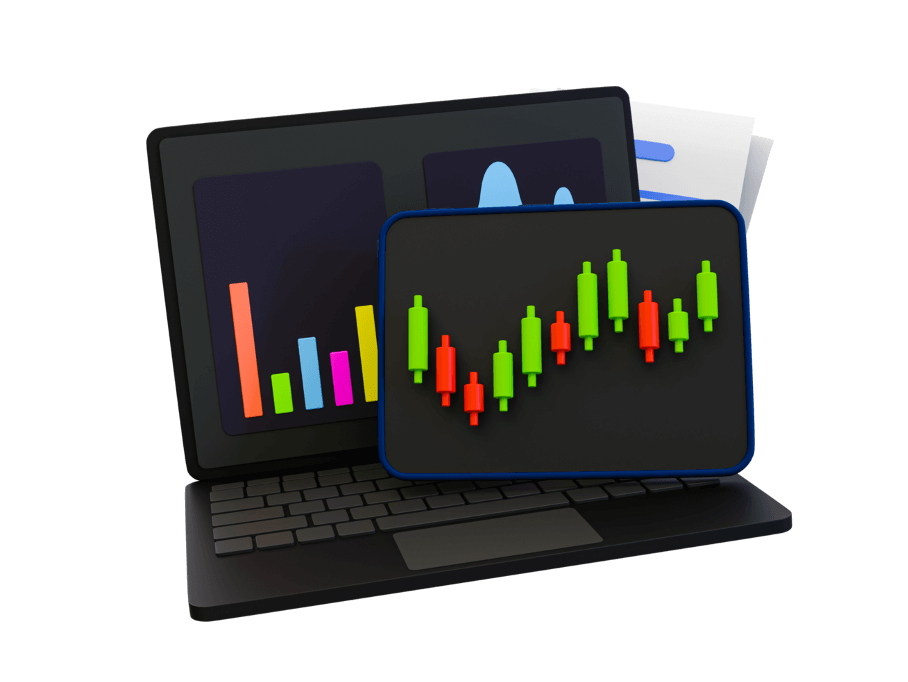
Published: 05/04/24
Whether you trade cryptocurrency, forex or EFTs (exchange-traded funds), developing and deploying a comprehensive financial management strategy is key to long-term success.
Financial management in trading is vital for minimising risk and achieving growth by having optimal position sizes. According to Moneyshow, 90% of traders frequently lose money in the markets, resulting in a cycle of instability.
However, money management can prevent these losses and protect your investments. In this guide, we’ll reveal some top tips for getting the most out of your forex, EFT, and crypto trading strategies.
Disclaimer: This content may contain affiliate links, which means Getsby earns a commission if you click on the link and sign up for the platform. We only recommend products and services that align with our commitment to offering our readers value and advice.
What is financial management in trading?
 Regardless of the markets you’re trading in, volatility is part of the process. Gains can quickly become losses, and not having a strategy can put your investments at risk. Financial management is a set of rules traders set to protect their money.
Regardless of the markets you’re trading in, volatility is part of the process. Gains can quickly become losses, and not having a strategy can put your investments at risk. Financial management is a set of rules traders set to protect their money.
While risk management looks at the potential downfalls of investing in specific markets, money management focuses on protecting your funds and preventing losses.
Stable investments always have the opportunity to turn into profits, but losses are often unrecoverable. By maximising gains and reducing losses, anyone can become a successful trader.
With that in mind, let’s explore some crucial money management tips.
Tip 1: Know your markets
EFT, forex, and cryptocurrency markets undergo significant changes due to economic events, politics, and demand. Successful traders know that staying updated with any changes is integral to managing their money effectively.
Even a small event can cause a significant downturn in the market, but on the plus side, capitalising on market alterations is a profit-making opportunity.
Staying updated with your markets makes it possible to prevent losses and go into each trade with clarity. Luckily, there are numerous publications available for traders, with the most popular options including:
- Forex: FXStreet
- Cryptocurrency: Bitcoin Magazine
- EFT: Financial Times EFT Hub
- General EU Market Updates: Reuters
These resources offer instant updates and the latest market news, letting you stay ahead of the curve and adjust your investments accordingly.
Tip 2: Determine your risk per trade
Risk per trade quantification is intrinsic to financial protection. It enables you to define how much you’re willing to lose on each trade. Some people have a high risk tolerance, while others will need to set clear stop-loss orders.
Following these steps can help you set a comfortable risk amount:
- Look at your financial situation and determine how much risk you’re comfortable with.
- Define a set percentage of trading capital you’re willing to risk per trade—most traders set it at between 1% and 3%.
- Use the percentage and available capital to calculate your position size, then implement the stop-loss order.
- Look at your trading assets and adjust the position size based on their volatility.
- Regularly assess your limits and decide whether you want to adjust the strategy for better results.
Tip 3: Set strict limits
One of the most valuable tips for traders is to set realistic limits and only spend what you can afford. It’s easy to get carried away and deposit a large amount of money, but this puts you at more risk of losses.
Setting a realistic monthly loss amount ensures you’re only risking what you can afford.
For example, if you have €1,000 left over each month after your expenses, losing it won’t cause any financial issues. However, spending a large amount of your income on trading can result in significant money worries.
For this reason, many traders avoid using traditional credit and debit cards in favour of prepaid cards. They purchase a virtual card online and preload it with a set limit, which means they only spend what’s on the card, protecting their bank accounts.
Tip 4: Portfolio diversification
As the saying goes, don’t put all your eggs in one basket. The best way to prevent significant losses is to diversify your investment portfolio.
By spreading your investments across various markets, it’s easier to strike a balance between calculated risks and potential gains.
You can achieve portfolio diversification in many ways, including:
- Allocations: Many traders focus on a combination of EFTs, cryptocurrency, and forex markets for a robust portfolio with greater stability.
- Sectors: Making investments in different sectors is always a good idea. Investing in stable industries and emerging sectors can prove highly beneficial.
- Locations: Many traders also invest in sectors and companies in different countries to reduce the impact of localised events.
- Time: Market downturns can significantly impact your investments, but spreading them over different periods can prevent losses.
- Companies: Again, investing in just one company means you’re relying on that company’s survival. Choosing different businesses to invest in offers more peace of mind.
Portfolio diversification will reduce some risks, but there are always potential losses when investing money.
Tip 5: Choose your platform wisely
There are plenty of trading platforms available, but not all of them offer users a secure experience. Choosing the right platform is integral to protecting your money and personal information while enjoying seamless transactions.
Reputable platforms will be fully regulated by the countries they operate within and integrate security measures. Trading services such as AvaTrade have education centres and numerous resources to help traders safeguard their investments.
Performing due diligence before signing up for a trading website gives you long-term peace of mind and transparency regarding commission costs.
Tip 6: Use technology wisely
Artificial intelligence is changing the way we work, communicate and invest. In the past, trading was only accessible to trained professionals, but robo-advisors are facilitating the democratisation of trading.
However, while machine learning has benefits, it’s not a replacement for human traders with years of experience in the industry. Relying on machine learning alone often means investors don’t recognise and appreciate the risks associated with each trade.
As Sage Journals reports, algorithmic trading can expose people to more risks, especially if they lack an in-depth understanding of the market.
Tip 7: Regularly assess your money management strategy
Trading is an ongoing process that involves ups and downs. It’s easy to become impulsive when the market experiences a downturn, but focusing on your strategy and being patient can prevent losses.
Discipline is vital for traders who want to see a return on their investments and take steps to balance their emotions during fluctuations. Once you understand how your strategies are performing, you can adapt them to suit the market.
Tip 8: Monitor for regulatory changes
Understanding your responsibilities as a trader can protect your investments and reputation. Regulations can change due to many factors, including the impact of taxes on your responsibilities.
Monitoring the markets and countries you usually invest in ensures compliance and prevents repercussions.
Prioritise money management with Getsby
Getsby makes it easy for you to stay safe online and take control of your trading account. Our Premium Virtual Mastercard – Black Edition is a single-load payment solution that lets you preload it and make transactions on your trading platform.
With a range of features, including superior security, a convenient €500 load limit and up to 25 cards a month, our Black Card aligns perfectly with your financial management plan.
Order yours online today and enjoy the safe way to invest in your future.



